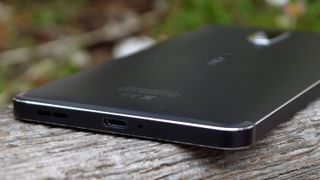Why you can trust TechRadar
Battery life
- Will last you a day, just, with average usage
- Charges slowly; 30 minutes gives you around 10%
The Nokia 6 comes with a non-removable 3,000mAh battery which can see out a day on a single charge with general usage, but don’t expect anything more than that.
Considering this handset is larger than the Nokia 5 it’s a shame that a bigger battery hasn’t been squeezed in, as you’ll find yourself running out of juice before the day is over if you spend a couple of hours streaming music and playing games.
From taking the phone off charge at 7am, and spending around 90 minutes streaming Spotify while also playing games for roughly 40 minutes of that time, the Nokia 6 generally dropped about 20% of its life by 9am.
During the day, when the phone was mostly left on standby on a desk and used for just the occasional phone call and WhatsApp message, the battery drain was much reduced – but leaving the office with less than 50% was common.
We put the Nokia 6 through our standard battery test, which involves playing a 90-minute Full HD video, with screen brightness on full and accounts syncing over Wi-Fi in the background, and it lost 22% of its battery life. That’s not a bad result, putting it on a par with the Moto G5, but it’s not as good as the Moto G5 Plus, which lost just 12%.
Fast charging would soften the blow of the uninspiring battery life, but the Nokia 6 doesn’t offer that through its micro USB port. On the contrary, charging is incredibly slow, and you’re looking at up to six hours to fully charge if you plug in below 10%.
In general we found the Nokia 6 took around 30 minutes to restore 10% of battery when left on standby, with three hours of charge timing getting you to 60%. These charging speeds can be increased by switching the handset off, but then you lose all connectivity.
This means that if you use the phone more frequently you’ll need to plan a charge an hour or so before you leave the office to ensure you can last until bedtime.

Camera
- 16MP rear camera is a solid snapper for the price tag
- 8MP front camera suffices for Snapchat and selfies
The Nokia 6 boasts a 16MP camera on its rear, which for a low-cost handset isn’t a bad spec to have on the sheet, and for the most part it’s a solid snapper.
The camera block, which also houses the dual-tone LED flash, protrudes slightly from the back of the phone, which did make us nervous when plonking it down on a hard surface, so we’d recommend treating it with a little care to protect the lens.
On-screen, the camera app is pretty straightforward, with a centralized shutter key flanked by a video recording button and a link to your gallery. At the top of the display quick settings for HDR, flash and timer are joined by the toggle that switches you between the front and rear cameras.

Delving into the settings menu there’s not a great deal to write home about, and there’s no pro or manual mode for those who like to tweak settings such as ISO or shutter speed.
The large 5.5-inch Full HD display works well as a viewfinder, while you can use the volume keys on the side of the handset as a shutter button, which is sometimes easier than stretching for the on-screen button.
It’s a simplistic offering then, but one that works well in most scenarios. Images shot in good light tend to have good detail and depth, but the Nokia 6 can struggle a little in low light and indoors. Its camera is comfortably better than those on the Nokia 3 and Nokia 5 though.
Round the front the 8MP selfie snapper is more than serviceable for the occasional vanity shot, or a quick video chat or Snapchat recording.
Nokia 6 camera samples gallery










Current page: Battery life and camera
Prev Page Introduction, price and design Next Page Anything else I should know?
John joined TechRadar over a decade ago as Staff Writer for Phones, and over the years has built up a vast knowledge of the tech industry. He's interviewed CEOs from some of the world's biggest tech firms, visited their HQs and has appeared on live TV and radio, including Sky News, BBC News, BBC World News, Al Jazeera, LBC and BBC Radio 4. Originally specializing in phones, tablets and wearables, John is now TechRadar's resident automotive expert, reviewing the latest and greatest EVs and PHEVs on the market. John also looks after the day-to-day running of the site.
